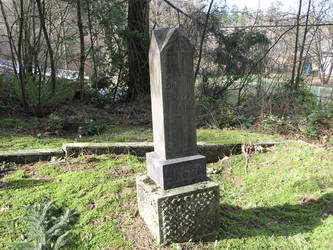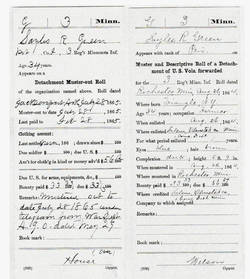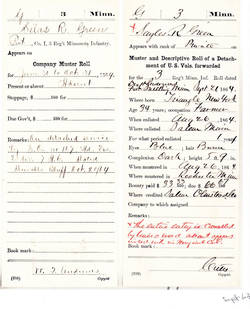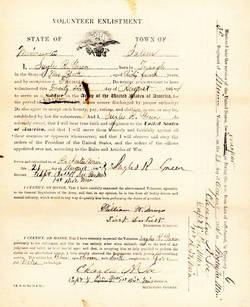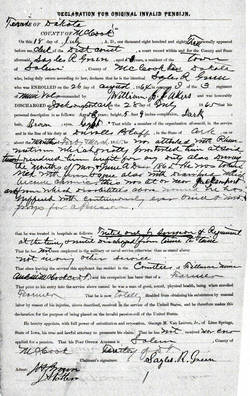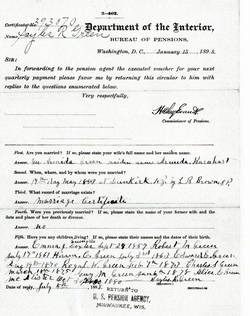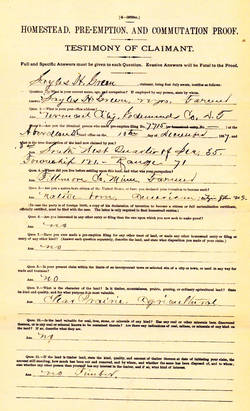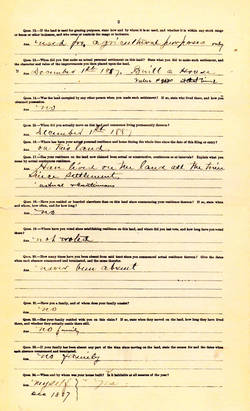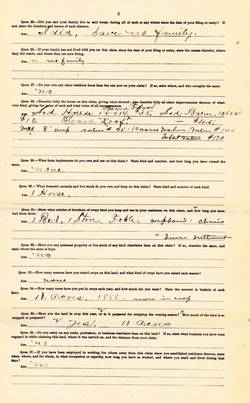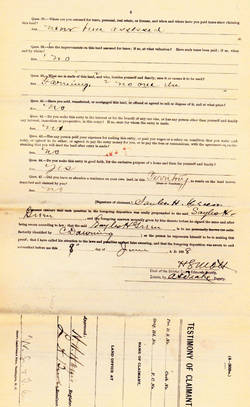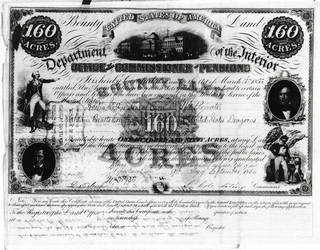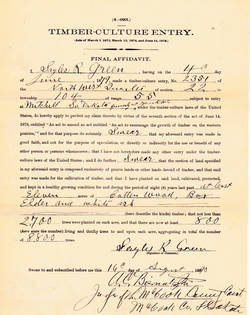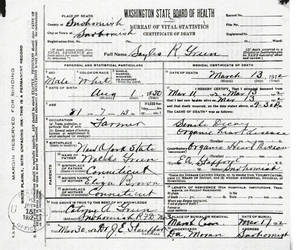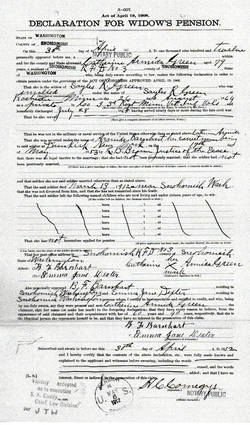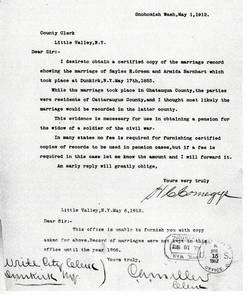Sayles Ross Green
Representing: Union
G.A.R Post
- Oliver Morton Post #10 Snohomish, Snohomish Co. WA
Unit History
- 4th Minnesota Infantry I
Full Unit History
REGIMENTAL HISTORY
Organized: Summer & Fall, 1861 Ft. Snelling Minneapolis, MN
Mustered In: 10/1 or 11/15/61 Ft. Snelling Minneapolis, MN
Mustered Out: 9/2/65 Devall's Bluff, AR
Regimental History
REGIMENTAL HISTORY:
The 3rd a three year "western theater" regiment was organized during the summer and fall of 1861. Following Federal muster it left the state for Louisville, KY and, from there, late in the year, moved on to Shepherdsville where six companies were detailed to guard bridges with the other four moving to Lebanon Junction for the same duties.
In March, 1862 the unit was encamped at Nashville, TN. From there it marched to Murfreesboro where, in July, it was attacked by the Rebel cavalry under Nathan Bedford Forrest. Against the protests of most of the men on the line, the regiment was surrendered in masse to the enemy. A trip to Libby Prison in Richmond preceded parole and a return to Nashville. At that place the men were criticized for surrendering and encouraged to break their paroles. The men of the 3rd refused. A period in the field in Minnesota helping to quell Indian raids then followed. The regiment ended the year stationed at Ft. Snelling, MN.
1863. After being reorganized, the 3rd left the state of Minnesota once again in late January, moving to Cairo, IL and from there to Columbus, KY. In May it was ordered to Vicksburg, MS where it remained until the fall of that city on July the 4th.
In late July, '63 the unit moved into Arkansas where, in September, it was present at the engagement of Bayou Fourche. Reenlistment of most of the regiment's men followed at the end of the year.
In April, 1864 a detachment of the 3rd took part in a sharp skirmish with the Rebs in Arkansas known as the battle of Fitzhugh's Woods. The regiment was then involved in the inauguration of Isaac Murphy, Arkansas' first Free State governor. For the summer, the regiment settled near Pine Bluff where it suffered greatly from malarial poisoning. In October the unit quartered at Devall's Bluff for the winter. There it performed picket and scouting duties.
May, 1865. The 3rd moved to Batesville and hence to Jacksonport. From there companies "D" and "G" were returned to Batesville while "A" and "F" were sent to Searcy, "E" and "H" to August and "C" and "I" to Powhatan. The War having ended, final muster came at Devall's Bluff on 9/2/65.
Regimental losses: Officers killed or mortally wounded: 0; Officers died of disease, accidents, etc.: 4; Enlisted men killed or mortally wounded: 17; Enlisted men died of disease, accidents, etc.: 275.
Soldier History
SOLDIER:
Residence: Salem, Olmstead Co., MN Age: 34.0 yrs.
Enlisted/Enrolled: 8/26/64 Rochester, MN Rank: Pvt.
Mustered In: 8/26/64 Rochester, MN
Mustered Out: 9/2/65 Devall’s Bluff, AR
Highest Rank: Pvt.
Family History
PERSONAL/FAMILY HISTORY:
Sayles Ross Green was born August 1, 1830 in Triangle, Broome County, NY. His parents were Waldo Edward Wakeman Green (b. 1802 RI) and Eliza (nee Brown b. 1806 NH) Green. Although no documentation is available to support this theory, likely the Greens were a farming family. Little is known about the Green patriarch because he died in 1835 when Sayles was but four or five years of age.
Documentarily it is known that Sayles had two older and three younger siblings. Those older were Louisa (b. 1821) and Royal (b.1828). The younger three were Diantha (b. 1832), Eli Waldo (b. 1835) and Edward (b. 1836). Obviously Eliza was pregnant with Edward when her husband passed away. All of the Green children were birthed in Triangle, NY.
After her husband's death Eliza remarried to Eli Yarnes who had children of his own from a prior marriage. With whom the Green children grew to adulthood is not known as the only name found in conjunction with Eliza and Eli Yarnes is Eli Green. As a side note, Eliza Brown/Green/Yarnes died in Minnesota in 1887.
The first documentation specifically pertaining to Sayles comes from 1853 when, on May the 17th, in Dunkirk Chataqua Co., NY he married to Catherine Armida/Arminda/Armidia Barnhart (b.1833 NY). Neither of the newlyweds had been previously married. Sayles and Catherine would become the parents of twelve children. Of the twelve, the names of only ten are documented. The Green children as named were: Emma Jane (b. 9/28/57 IA); Walter (b. 1/59); Robert M. (b. 7/17/61 MN); Hiram C. (7/3/63 MN); Edward E.(b. 8/19/67?); Susan "Susie" H. (b. ca. 1867 MN): E.H. (b. 1870 MN ); Royal W. (b. 2/7/73 MN); Charles S. (b. 3/18/75 MN); Guy M. (b. 1/5/78 MN) and Alice E. (b. 10/30/80 Dak). As of 1910 seven of the ten were living.
Exactly where Sayles and Catherine set up house following their nuptials is not known. However, as of October, 1856 they were in Fellman County, Minnesota. Interestingly, no such county name exists in Minnesota today, so obviously the name was later changed. There, or near there, Sayles purchased a 160 acre homestead tract from the widow of a Mexican War veteran. As best as can be determined, he worked the claim for a time then apparently sold it and moved on to Iowa where first daughter Emma was born. The Iowa stay was short lived, too, as when son Walter was born in January, 1859 his place of birth was in Minnesota.
The U.S. Census for 1860 found the Greens farming in or near the community of York located in Fillmore County, Minnesota. Under the household roof at the time besides Sayles and "Arminda" were children Emma and Walter plus Armida's father Henry David Barnhart.
The next, what we might call momentous event in Sayles life came in August, 1864 when - with the U.S. embroiled in the third year of what was to be a bloody four year civil war - he decided to leave his family and serve in the U.S. Army for a period of one year. By that time the family he left behind had grown with the addition of sons Robert in mid-1861 and Hiram in mid '63. What had prompted him to leave them a join the army? Perhaps it was the lure of a $100 enlistment bonus or "bounty", one third of which was paid at the time of enlistment and the other two thirds in two later increments. At a time when a private soldier's pay was $13 per month $100 was a "lot" of money.
It is at the time of Sayles' enlistment that we gain our first look at the physical man himself. For example, 34 year old farmer and now Private Green - was well above the median age of a Civil War combatant who was aged 27.5 years; he was 5'9" tall, had blue eyes, a dark complexion and brown hair. Of particular interest is that he (and his family) were then residents of the community of Salem located in Olmstead County, MN. His enlistment was credited to that area's first congressional district.
Private Green's period of military service would prove to be less than one year. Also, it would be fairly benign in terms of immediate or lasting impacts upon his life. He apparently did not see any combat. In fact, after leaving the recruit rendezvous depot at Ft. Snelling Minnesota and joining his company and regiment in the field, he spent most - if not all - of his time absent from the former on detached duty with the divisional quartermaster (material supply) department. Perhaps this was due to his "older than average" age. The only apparent negative to befall him was a six day hospital stay for intermittent fever in July, 1865 just prior to his muster out date of 7/28.
While it seems likely Sayles returned from the military to his family residence in Salem, MN, we do not know that documentally. While there is at least a hint that he resettled in or near a community called Canfield, even that is not known for sure. What is known is that as of 1870 when the next U.S. Census tally was made the Greens - Sayles, "Almina", Edward, Robert and Hiram - were in Fillmore, York Co., MN with Sayles once again listing his occupation as "farmer."
As best as can be determined Sayles left Minnesota and his family to move to Dakota Territory before or during May, 1879. There, it appears he, alone, settled on a 160 acre tract of treeless rangeland located “in a little valley” in Cameron County (Now in South Dakota) he travelled to the Yangston (or Mitchell) Land Office and filed papers to obtain a Timber Culture homestead.*
[*NOTE: The Timber Culture Act was a follow-up act to the Homestead Act of 1862. The goal of the act was the planting of trees on the prairie since it was – misguidedly – believed that trees attracted rain clouds. Further, the wood from the trees could be utilized by settlers as construction material and fuel.
Passed by Congress in 1873 Timber Culture Act allowed homesteaders to obtain patent (deed) on a first or second 160 acres (65 ha) if they planted trees on one quarter of the land and nurtured them for ten years. Because of fraud and abuse the act was rescinded in 1891, but by that time the 30 percent of the claims which were successfully completed resulted in many hundreds of acres of treeless plain having been seeded with trees. It is said that many of the groves of trees found today in southwest Minnesota and the Dakotas are the result of the Timber Culture Act.]
In a document filed on 8/16/90 Sayles – who, with his family was by that time living in present day Seattle, WA described the land “Improvements” he had implemented on his Timber Culture land:
I had at least six acres broken in May, 1880 with a breaking plow and two yoke of oxen. Six more were cultivated in the spring of 1881.That ground was seeded to oats and plowed to save it for the fall. The ground was measured with a tape line.
I had at least five acres broken in May, 1881 with a breaking plow and two horse teams. Those acres were planted to corn. I check set the same ground in the fall of 1881. I the seeded same to oats and cultivated it in the spring of 1882.The same ground was then again thoroughly plowed and cultivated in the fall of 1882. Again, the ground was measure with a tape line.
I cultivated and marked the first six acres in rows four feet apart each way in 1882 and said six acres of ground was thoroughly planted with cotton wood trees – at least 2700 upon each acre in April, 1882 and in good condition I measured the ground with a tape line.
I cultivated and marked an additional five acres in squares four feet apart every way in April and May, 1883 and planted those five acres in box elder and white oak trees, at least 2700 per acre. This was during the fourth year. The cultivating and planting was done thoroughly and marked with a tape line.
Three of the first six acres of trees failed to grow in 1882. I replaced them in the fall, cultivated and marked the same acres in squares four feet apart each way in April and May, 1883. The replanting was done with box elder and white oak trees, at least 2700 on each acre. The cultivating and planting was thorough.
During eight years past I have planted at least eleven acres. The trees are in a good, healthy, thrifty growing condition. Their average diameter is four inches. Their average height is at least twelve feet. There are at least 800 such trees in cotton wood, box elder and white oak upon each acre. In addition to the treed acreage, I have seventy five acres broken and under cultivation. On 6/23/91 Sayles received the patent (deed) to his tree land. However, the ultimate dispositional fate of the tract is not known.
It appears that while this Tree Culture development was going on, the rest of the Green family had remained in Fillmore, Minnesota, but by the early 1880s – say 1880 or ‘81 – he had retrieved them and they all moved to the Dakotas settling in or near the McCook County community of Salem.
From all appearances the land on which the Greens settled was a homestead tract which, as in Minnesota, had been claimed by another, but never developed. Shortly thereafter, on June 3rd, Sayles drew upon his period of military service to apply for the 160 62/100 acre tract. Two days later the Sioux Falls federal land office received $14 from him in payment for this second tract of land which Sayles then also began to "improve".
Over the next five years those improvements included construction of a 20’ x 26’ wood frame house, a 24’ x 60’ stable, a corncrib, grainery and well. One hundred acres were tilled or "broken" and planted. Forty to sixty acres of the site were fenced.
On 7/25/85 through the land office of Mitchell, Dakota Terr. Sayles began the final paperwork to gain patent or "deed" to the homestead land on which he, his wife and seven children had resided during the previous five years. That patent was ordered on 8/11/85, approved on 2/5/86 and granted on 12/29/87. The Greens were owners of their own land in a community by now named Salem, McCook County, Dakota Terr. Today both Salem and McCook are in the State of South Dakota.
*************************************************************************************************************************************
As Sayles was residing upon, working on and wrapping up ownership of his Dakota homestead tract, he was also actively involved in the paper chase associated with attempting to obtain a U.S. Government disability pension stipend based on illnesses and injuries which traced back to his days of Civil War soldiering. In Sayles case this process began on 7/18/83 with him alleging that on or about February/March, 1865 while stationed at Devall's Bluff, Arkansas he had been attacked by rheumatism and, about May/June, 1865 while at Jacksonport, Arkansas he had contracted fever, ague and chronic diarrhea. All the afflictions listed had made him unfit for duty at the time and had plagued him ever since. As was the usual in cases such as this the pension vestment process dragged on for several years involving hearings, depositions from former soldier comrades and medical examinations.
Finally, on a date not available, former infantry Private Sayles R. Green was pensioned at the rate of $2 per month because of the rheumatism. On 5/4/88 while still a resident of Salem, McCook County, Dakota Terr. an increase from the $2 payment level was sought on the grounds that the rheumatism had grown worse. Further, the former soldier expressed grievance because he had not previously been found disabled by chronic diarrhea. A medical exam was requested.
Whether or not the medical exam requested in 1888 ever took place is not known. However, by 9/4/89 Sayles (and family) then residents of Edgewater, King County, Washington Territory sought a pension payment increase because by then he was suffering from disease of the heart caused by the rheumatism plus piles (hemorrhoids) as well disease of the rectum which were the result of diarrhea from which he had suffered since discharged from the service.
What had drawn the Green clan westward from the Dakotas to the shores of Puget Sound in Western Washington Territory/soon-to-be State is not known. On 9/4/89 their first Washington address was the previously noted Edgewater - a now unknown location - in King County. A population tally taken that same year noted the Green family's address as Fremont, King County, WA. (Today, Fremont is an area of north Seattle.) The household at that time was noted as composed of Sayles, Catherine and children Robert (28 MN), E.H. (19 MN), Royal (17 MN), Charles (15 MN), Guy (13 MN) and Alice (9 Dak). Also in the home was Robert’s wife, Susie and their four year old child and Elair. No occupation is listed for Sayles supporting this brood.
Most of the U.S. Census for 1890 was destroyed by fire, but a King County, Washington survey conducted in 1892 listed the Green household as being comprised of S.R. and Catherine, but now with only two children under their roof: S.H. (24 1867) and Chas (17 1875). By this time the family address was listed simply as Seattle.
Eight years later, in 1900, the Census found Sayles, Catherine and son Guy (22) living north of Seattle and King County in an area known as Marsh located slightly east of the City of Everett in Snohomish County. What had drawn the family to that locale is not documented.
1910. A New decade. A new census. That year's tally placed Sayles and Catherine still in or around the community/region of Marsh. While none of their children were in the home, residing with them was Armida's brother, Benjamin F. Barnhart who, reportedly, was also a Civil War veteran.
Former Civil War infantry Private Sayles Ross Green died March 13, 1912 in Marsh. At death he was 81.7 years of age. Cause of his passing was senile decay and organic heart disease (contributing). Burial was/is in the Marshland cemetery.
On 4/30/12, in Snohomish, Snohomish County, WA. - Marsh was apparently part of thre Snohomish post office catchment area - only weeks after her husband's death Catherine applied to the U.S. Government to continue receiving at least a portion of Sayles's military disability pension. Assisting her with the paperwork process was her brother Benjamin and married daughter Emma Jane Dexter. When signing the appropriate documents Catherine made her (X) mark.............
The Census of 1920 found the 86 year old widow Green living in her Marsh home. With her were son Guy and Brother Benjamin. She died on 11/20 of that same year and was/is buried beside Sayles in the Marshland cemetery.
Cemetery
Buried at Marshland Cemetery
